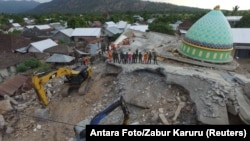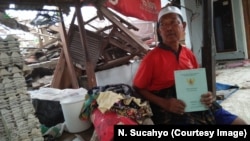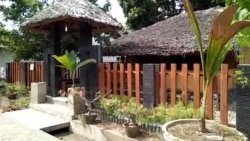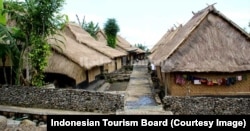As villagers attended the first Friday prayers after a week marked by two major earthquakes and aftershocks, they returned to Karang Baro Mosque which was so damaged they gathered outside for worship.
Joined by volunteers and Indonesian National Police officers, about 300 people heard a sermon by Guru Lalu Ahmad asking for strength in facing the disaster and patience, sorely needed by the faithful who had been waiting through construction for the official opening of their mosque now too dangerous to enter.
WATCH: First Friday Prayers at Karang Baro Mosque After the Earthquakes
Across Lombok, officials estimate the major earthquakes August 5 and August 9, magnitudes 6.9 and 5.9 respectively according to the U.S. Geological Survey (USGS), destroyed more than 100,000 homes. In the village of Prawira, it looks as if most of the houses built of concrete, like the mosque, are close to collapse, if not felled.
But Raden Prawangsa Jaya Ningrat, a youth cultural activist in Prawira, said that most of his neighbors still have their homes because they understood the wisdom of living in traditional wooden houses.
Geographically, Indonesia lies on several active tectonic plates, making it one of the world’s most active seismic zones. The so-called Ring of Fire is the zone surrounding the Pacific Ocean, where some 90 percent of the world’s earthquakes occur.
That means in Prawira, little earthquakes occur almost daily, those with a magnitude of 5 or higher are weekly events, and when big ones occur, wooden houses move while concrete ones don’t.
Although a number of traditional local homes in Prawira have been renovated, even then builders used natural materials such as wood and bamboo, according to Prawangsa, who added that the sight of collapsed concrete buildings have made local residents appreciate their architectural heritage.
“The traditional buildings, traditional houses are still standing,” Prawangsa told VOA Indonesian. “The others, built from concrete, collapsed. So we must pay more attention to the construction. We are located on the Ring of Fire. The most suitable materials for housing are natural materials such as wood, bamboo, woven bamboo walls because our area is prone to earthquakes.”
Indonesian construction experts like Yulianto Prihatmaji, who earned his doctorate in engineering from Kyoto University, Japan, and currently teaching at Islamic University of Indonesia, Yogyakarta, agree.
“During an earthquake, the wooden construction is able to move [and does not immediately collapse] and gives enough time for the occupants to escape safely,” he told VOA during a phone interview. Prihatmaji, who specializes in Indonesian traditional timber structures, surmised the builders in Lombok may not have used earthquake-resistant concrete.
In a traditional home, the main front entry is low, the techniques used to connect elements of the frame result in a strong but not rigid construction, and the thatch or woven coconut leaves used for the roofs are lightweight. The combination withstands earthquakes well, even, as residents pointed out, the big one of October 20, 1979, which the USGS registered at 6.2 magnitude.
Haji Fuadzi said the earthquake of 1979 damaged fewer houses.
“The houses back then were not damaged, the roof was made of reeds, the walls were of bamboo,” said Fuadzi, a Prawira resident whose concrete house displayed cracked walls that looked close to collapse. “It’s very different from the current buildings. The floor at that time was ordinary cement.”
Rummaging through the debris, he found the deed to his land and hoped to find “all the items that I can still use but I’m afraid to enter because it could collapse at any time,” he told VOA.
WATCH: Traditional Wooden House in Lombok
Prihatmaji pointed out that traditional Lombok wooden houses are small, limited by the length and span of the natural materials used in their construction. He added that the houses can be dismantled easily because the people of Lombok were once nomads, moving often in their search for farmland. He criticized the move to concrete construction by local people who perceive the wooden houses as outdated and shabby.
“When the shift to concrete buildings happened, they prioritized the appearance of the building, not the structural strength,” Prihatmaji said.
“It’s our duty to learn more about carpentry, natural materials and local culture,” he said. “Experiences in the past can be the answers for the future. For example, in the past, houses were smaller. So it would be wise to return to wooden houses in the future.
“But if one doesn’t want to, it’s OK,” said Prihatmaji. “The important thing is everyone understands that they live on plates that easily shake. So the houses must be as light as possible.”












